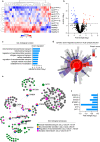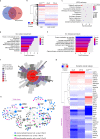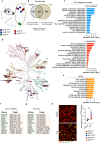Integrative proteomics highlight presynaptic alterations and c-Jun misactivation as convergent pathomechanisms in ALS
- PMID: 37488208
- PMCID: PMC10412488
- DOI: 10.1007/s00401-023-02611-y
Integrative proteomics highlight presynaptic alterations and c-Jun misactivation as convergent pathomechanisms in ALS
Erratum in
-
Correction to: Integrative proteomics highlight presynaptic alterations and c-Jun misactivation as convergent pathomechanisms in ALS.Acta Neuropathol. 2023 Nov;146(5):783. doi: 10.1007/s00401-023-02630-9. Acta Neuropathol. 2023. PMID: 37698628 Free PMC article. No abstract available.
Abstract
Amyotrophic Lateral Sclerosis (ALS) is a fatal neurodegenerative disease mainly affecting upper and lower motoneurons. Several functionally heterogeneous genes have been associated with the familial form of this disorder (fALS), depicting an extremely complex pathogenic landscape. This heterogeneity has limited the identification of an effective therapy, and this bleak prognosis will only improve with a greater understanding of convergent disease mechanisms. Recent evidence from human post-mortem material and diverse model systems has highlighted the synapse as a crucial structure actively involved in disease progression, suggesting that synaptic aberrations might represent a shared pathological feature across the ALS spectrum. To test this hypothesis, we performed the first comprehensive analysis of the synaptic proteome from post-mortem spinal cord and human iPSC-derived motoneurons carrying mutations in the major ALS genes. This integrated approach highlighted perturbations in the molecular machinery controlling vesicle release as a shared pathomechanism in ALS. Mechanistically, phosphoproteomic analysis linked the presynaptic vesicular phenotype to an accumulation of cytotoxic protein aggregates and to the pro-apoptotic activation of the transcription factor c-Jun, providing detailed insights into the shared pathobiochemistry in ALS. Notably, sub-chronic treatment of our iPSC-derived motoneurons with the fatty acid docosahexaenoic acid exerted a neuroprotective effect by efficiently rescuing the alterations revealed by our multidisciplinary approach. Together, this study provides strong evidence for the central and convergent role played by the synaptic microenvironment within the ALS spinal cord and highlights a potential therapeutic target that counteracts degeneration in a heterogeneous cohort of human motoneuron cultures.
Keywords: ALS; Motoneuron; Proteomics; Spinal cord; Synapse; hiPSC.
© 2023. The Author(s).
Figures





References
Publication types
MeSH terms
Substances
LinkOut - more resources
Full Text Sources
Medical
Miscellaneous

